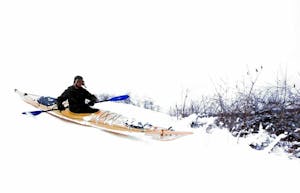The Joys & Risks of Winter Sea Kayaking
The Joys & Risks of Winter Sea Kayaking
By Zack Anchors
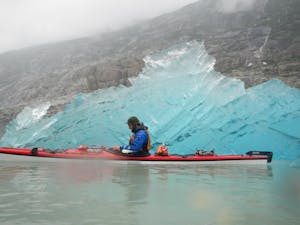
Zack paddling to the Le Comte Glacier in Southeast Alaska.
Like many sea kayak guides in Maine, I kayak every month of the year. And my winter paddles are often my favorite. When the lakes and rivers freeze and the snow piles up, the salty coastal waters are mostly ice-free, less crowded than usual and scattered with birds you probably wouldn’t see at any other time of year.
Winter paddling isn’t for everybody, though. It requires a high level of caution, some extra gear and meticulous planning. But if you’re up for the challenge, you’ll experience the coast in a way that very few people do and you’ll grow the usual 4-month paddling season by 200% into a year-round activity!
The Allure of Winter Paddling
Being on the ocean feels different in winter. There are far fewer boats around, and less activity in the harbors, so it can feel incredibly quiet and tranquil. Here are some of the ways that I find it uniquely satisfying.
Viewing Birds & Wildlife You Might Not See in Summer
While many birds leave the Maine coast in the fall in search of warmer climes, there are other birds that fly to Maine from the Arctic or subarctic regions seeking relatively milder conditions. These are some fascinating and beautiful birds, and watching them during a winter paddle is a lot easier than planning an expedition to the Arctic to see them in their summer breeding grounds.
Here are some of the birds you’re likely to spot:
- Surf Scoters, Long-Tailed Ducks, Common Goldeneyes, Buffleheads: It’s far more common to see these and other ducks and types of waterfowl on the ocean during winter. Loons, seen year-round, are also more likely to be seen on coastal waters in the colder months.
- Bald Eagles: Often seen perched along the shoreline, they are easier to spot when the leaves have left the trees, and they are majestic in the winter landscape.
- Auks: Razorbills and Dovekies are auks that breed in the Arctic but can be found in the waters off Maine during the colder season.
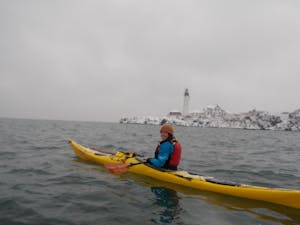
Portland Paddle guide Erin Quigley paddling to the Portland Head Light in Casco Bay
You’re more likely to spot harbor seals and gray seals in winter too. They’re present year-round, but tend to be the most active and visible during the colder months.
Keeping Your Body & Gear Fit & Ready to Paddle
The best way to keep your kayaking skills fresh and your body fit for paddling is to paddle regularly. And If you don’t paddle for several months each year it will be much mor
e difficult to develop the muscle memory needed to make new skills stick and to keep your paddling–centric muscles strong.
Likewise, there are advantages to using your kayak and your paddling gear consistently throughout the year. Paddling in winter will force you to get geared up for harsh conditions & cold water, which you really should be prepared to deal with at any time of the year on a coast with conditions as unpredictable and fluid as ours.
Bigger, More Dynamic Conditions
The winds on average are stronger during the winter months in the Gulf of Maine, and the waves tend to be bigger. The predominant wind direction also shifts, creating conditions that you’re less likely to have encountered during the summer and that may present unique challenges. Everyone appreciates the tranquility of gliding across glassy-calm waters, but many sea kayakers also enjoy the chance to surf some ocean swell, rock garden along a rocky coastline and make headway against a stiff headwind. Surfing, in particular, tends to be better in wintertime, so if you’re interested in honing the art of riding a wave it’s definitely worth getting used to winter paddling.
The Risks of Cold Water Paddling
You need to be super serious about safety if you’re going to kayak on the ocean in wintertime. Here are the main reasons why.
Exposure to Extreme Cold
Water temperatures along the coast of Maine are often just above freezing in the winter months. If you were to capsize in waters that cold, there are a few ways your body might react:
- Cold Water Shock: Dunking your body in frigid water will likely trigger cold water shock. This involves an immediate gasp reflex, and the hyperventilation it induces can lead to disorientation and danger. It can also impede your ability to perform a capsize recovery or complete other actions needed to keep yourself out of the water and warm.
- Hypothermia: It’s a major threat for sea kayakers year-round, but in winter hypothermia can happen incredibly fast. And even if you are able to avoid prolonged exposure to water, that might not be enough to keep your body temp from sliding into hypothermia depending on the conditions and the state of your body.
- Finger Numbness: It’s extremely easy to lose feeling in your fingers when they are exposed to cold water, and that immediately makes it much more difficult to do everything you need to do to get warm – from capsize recovery to simply opening a drybag to retrieve a warm layer. You’ll also have more difficulty asking for help, whether that involves blowing a whistle or making a call on your VHF marine radio. I once went for a paddle during a blizzard and managed to stay warm the entire time — until I got back to my car and found that my hands were so numb I couldn’t open the bag that held my car keys. Fortunately, I was able to get in my friend’s car to warm up.
Limited Daylight
Summers days in Maine can have up to eight hours more daylight than summer days, allowing a much smaller margin for error in trip-planning. If you get delayed by an unexpectedly strong headwind, for instance, you’re more likely to end up paddling in the dark in the winter if you got a late start. And paddling in the dark brings navigational challenges and even greater exposure to cold.
Fewer Eyes on the Water
There are far fewer boaters on the water during the winter, which means there are far fewer people who are likely to see you if you need help. That makes it all the more important to follow some basic best practices, like leaving a float plan that lets somebody know where you are and when you’ll be back. Having a VHF marine radio on your body and knowing how to use it is also essential.
Essential Gear for Cold Water Paddling
Whether you’re paddling in summer or winter, the key to preventing hypothermia is dressing for immersion. That means you choose what to wear not based on the air temperature but instead based on the assumption you may end up immersed in the water.
Protect the Core with a Drysuit or Wetsuit
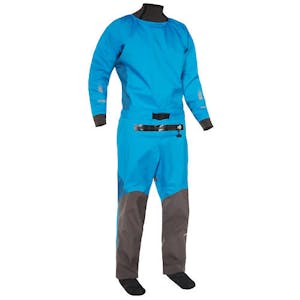
Most sea kayakers who paddle in winter wear drysuits. A thick wetsuit like surfers wear during the winter can also work extremely well at keeping a body warm, especially if you also wear wind-blocking outer layers.
In case you don’t know much about the difference between drysuits and wetsuits, here’s the basics: Drysuits fit loosely and seal out water with rubber gaskets around your neck and wrists, creating a pocket of air between your skin and the suit that your body warms. Wetsuits, on the other hand, fit tight to your body and hold a layer of water between your skin and the suit that your body warms.
Why do many sea kayakers prefer drysuits? First, you can layer as much as you like under a drysuit, so there’s a lot more flexibility in terms of preparing for different conditions. And when you’re done paddling, you can take your drysuit off and you’re nice and dry underneath – ready for whatever land-based activity is next. There’s no need to strip off wet layers in a parking lot and expose your skin while you change. And if you layer appropriately a drysuit has the potential to keep you warmer than a wetsuit and hold off hypothermia for longer. Because the fit more loosely, drysuits also restrict your range of motion less than a thick wetsuit, generally making them more comfortable.
One big downside of drysuits is that they are usually very expensive, often ranging between $750 and $1400. And they are subject to leaks that require repairs.
Use Mittens or Pogies to Keep Fingers Working

Cold fingers lead to major risks, so it’s essential to have a solid plan to keep them warm. I find that neoprene mittens are the most reliable way to keep my hands warm, but I usually carry three other ways to protect my hands during the wintertime. That way I have a backup if I lose one of my mittens. And I also find that mittens can be overkill on warmer days.
The second type of hand protection I carry is a pair of pogies. Unique to kayaking, pogies attach around your paddle with velcro and then you slide your hands into them. They retain a lot of warmth, and can be used in conjunction with gloves or mittens for extra protection.
A thick pair of fleece gloves is the third type of hand protection I carry. I don’t intend to use these on the water while paddling. These are meant to be used when I land, either for a break or at the end of my trip. And they are also with me in case somebody gets hypothermia and needs to be warmed. I’m careful to keep them well protected from dampness in a drybag.
Use a Hood or Hat to Retain Warmth
Just as I carry several forms of hand protection in wintertime, I also bring along several forms of head protection. Putting on a hat is such an easy way to warm someone, and I can easily stuff a few hats into a small drybag that I keep within reach. Most often I wear a thick wool or fleece hat while paddling, but if I’m facing rough conditions that make a capsize seem more likely, I might opt instead for a neoprene cap or hood that will be especially good at keeping my head warm if it gets wet. If your drysuit or paddling jacket has a hood, wearing it over a hat is a great way to get both layering warmth and wind protection.
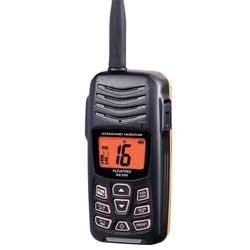
Carry a Way to Communicate, and Other Critical Safety Items
It’s always wise to carry a VHF marine radio, but it’s especially critical in winter to carry one and keep it on your body so you can access it even if you capsize and lose your boat. This will be the best way to get help in a crisis. It’s also especially important to make yourself reasonably visible during wintertime. With limited daylight, and a higher potential for snow and rain, it could be more difficult for you to be found if you needed help. And of course you should always carry all the other safety gear we reccommend sea kayakers use, including a paddle float, bilge pump, first aid kit, compass, nautical chart and tow belt.
Be Prepared for a Capsize with a Hypo Kit
If somebody in your group ends up with hypothermia, you’ll need a way to warm them up. That’s why I recommend you always carry a drybag that you designate as a “hypo kit” and fill it with items that are only meant to be used to warm up a cold person. This might include an extra warm bottom and top layers, a bivy sack (or sleeping bag or bothy bag), mittens, a hat, an outer wind-blocking layer, a sugary snack and chemical hand/feet warmers.
Get Out There and Paddle a Snow-Lined Coastline — If You’re Really Ready
Before you join a crew of kayakers headed out in frigid temps, take a moment for some honest self-assessment. Are you confident in your ability to perform a roll or some other capsize recovery technique in freezing waters? Do you have the gear needed to keep your whole body warm? Are your paddling skills up for handling the rougher waters you might encounter in winter? If you can’t answer these questions with a firm “yes,” it’s best to first find opportunities to gain the skills and/or gear needed. Consider signing up for a pool session, looking online for used gear or checking with local outfitters or paddling clubs for opportunities to learn and practice. You could also join one of Portland Paddle’s guided winter trips and take advantage of the included drysuit and the expertise of a guide.
And if it’s not the right time for winter kayaking, give a shot at kayak-sledding!
